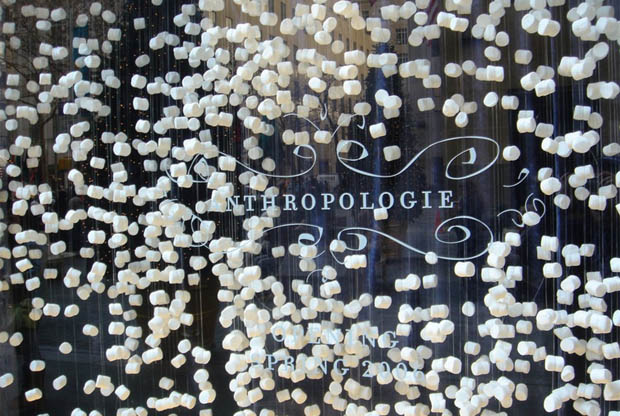Digital technology made brand communications more affordable, more dynamic and more accessible. However the ‘democracy’ of the web and all its works has also made it harder to maintain the quality and effectiveness of brand management. Too often digital methods lead to bad DIY marcomms that forget the basics – like how to do a decent print piece.
Anthropologie (Anthro to its customers) is a well-known upper mid-market US brand relatively new to the UK and Europe. Their Regent Street, London store – best described as spectacular – opened only in 2009. They are the grown up wing of the much better known Urban Outfitters. Urban Outfitters, which targets a youth market, has either courted or stumbled into controversy on political and social issues but that’s for another blog, maybe. Anthro came on the scene in 1992, 20 years after Urban Outfitters was first launched as Free People. It’s appeal is to the same mindset.
Anthro stores are beautiful, usually. They stock beautiful things, in a particular style, but still beautiful. They are self-consciously middle-class and mildly eccentric. People who shop at Anthro know what to expect from the women’s clothing, homeware and gifts. In the many hours I’ve spent in Anthro stores (which generously provide sofas and beautiful books to leaf through) I have often been the only man in the store. Anthro is also rather expensive, particularly so outside North America.
The Anthro Christmas brochure fell through the letterbox yesterday. Of course it is a beautiful thing, in every respect art but a design and communications failure that lets down the brand. Why? Because it forgets the basics and the ‘joins’ between art direction, photographic, typographic and (when one looks as prompted) on-screen design are all too obvious and because the basics including the understanding of print processes have been forgotten along the way.
Five specifics:
- Photographs lacking in contrast, failing to do justice to the products.
- Products shown too small to do justice to their loveliness.
- Products displayed in a way that means they cannot be seen.
- A failure to understand that certain paper stocks absorb ink and so make dark images even darker.
- Typography too small to see let alone read by most of the target age group
- A page design that fails to draw in the reader because there is no cohesive order.
All of this can be directed at much of their website too. The same failings producing the opposite result – too much bleaching out, too little focus, the wrong page order.
Don’t get me wrong, there is some great stuff in there too. Anthro’s blog and their use of social media – Pinterest being a key sharing medium for this outfit – is engaging and a good example of how it can work. But if you are going to have an expensive, quality image then you have to follow it through. In days when hideously expensive 5×4 film was the medium of choice for studio product shots a little more care was taken over the results. Digital shouldn’t mean cheap. Brochures and website that looks as beautiful as the stores but in which the products are lost in a mudge of amateurism is a let-down for an otherwise quality brand.
Better luck next year, Anthro, in the meantime if you are interested in maintaining the quality of your brand or merely in ensuring that your digital and inbound marketing are not compromised by elementary errors then get on the phone to Public Impact or drop us an email.

